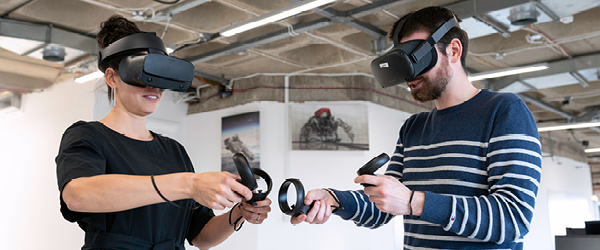FACTION Thoughts: Will virtual technology be adopted in projects?

Intern Jacky Zeng shares his thoughts on the use and uptake of this emerging technology.
Virtual technologies have rapidly become the technology of today, with the immersive experience provided by virtual technology [VT] allowing users to dive into an artificial world. VT describes a platform of established virtualization technologies including
Established in the 1950s, VT’s use was previously minimal due to high costs and lack of development. This changed as multi-million dollar companies like Google and Facebook jumped on the bandwagon, spearheading the way forward into the virtual digital realm.
A report published in 2018 by Market Research Future highlighted its predictions for the Virtual Reality market, estimating its worth at 101 Billion USD by 2027. These figures show the technology is expected to take off with no signs of slowing down.
There are many applications of VT in the field of property and construction project management, but will the industry move to adopt?
Training and development
VT is ideal for industry professionals that work with complex equipment, allowing them to learn and practice skills in a safe and controlled environment.
For example, paramedics are required to perform life-saving procedures on a regular basis. Continuous practice is essential if this procedure is to be performed successfully. VT gives learners an enhanced experience by catapulting them into a virtual environment that mimics real-life, without the risks associated when working on real people.
In complex projects, traditional methods of training through situational learning experiences have proven challenging. VT, however, has the potential to address such limitations by recruiting talented educators from around the world to teach within a space similar to that of a face-to-face classroom.
This not only removes the geographical restrictions that were once a constraint but also compresses the learning curve of project teams to allow them to keep pace with shortened project timeframes.
Augmentation in construction project management
Existing systems like computer-aided design [CAD] and Building Information Management [BIM] are core elements in construction-based projects. These systems, however, lack the ability to allow users to perceive three-dimensional scale images of the product/s being developed. VT helps fill this gap allowing the augmentation of products into physical spaces.
In the case of new machinery, augmentation of workspaces provides a level of information communication not offered by any other available technology.
The 1:1 interactive augmentation gives instant access to information, and a way for professionals of different trades and backgrounds to communicate issues or changes in an understandable manner, regardless of expertise.
The ability to view situations prior to implementation allows early detection of errors saving time and money, and prevents projects from spiraling out of control. Early detection mitigates and/or prevents potential errors and budget overrun from occurring before project maturation.
Adoption
In order for widespread ‘technology acceptance’ to occur, VT must be easy to use and not make users exert more energy than they would on a current system. Currently, individuals perceive the usefulness of VT as high but discern the ease of use as low. Age is also shown continually to moderate this, with older individuals proving less receptive to its integration.
Eventually, VT’s will become a mobile plug and play, and with a generational shift in management, we will likely see the integration of computer-human mediated interaction in project management. The shift towards computer-mediated interactions appears inevitable, as it is apparent already in many workplaces where software systems are used to increase productivity.
The future of VT
Although there are great benefits that VT can bring to projects, the technology is still largely in the experimental phase.
In addition, Australia has been particularly slow to adopt VT and lags behind other countries contributing little research in this area. Government bodies and private enterprises have recently taken notice of this and begun partnering to increase awareness of the space, funding the development of three new educational facilities worth $148 million AUD. These facilities will teach AR/VR along with other emerging technologies such as; robotics, drones, and AI.
If merged into a single platform, these technologies will deliver a superior capability, providing integrated, multifunctional systems. The development of such unified platforms would allow for easy transitions moving between different softwares that normally require complex procedures through gaming engines and third-party platforms. As such, the investment in this area is promising for increasing ease of use and the likelihood of widespread adoption.
Beyond single platform use, the obvious next step for VT is to move away from desktop-based systems towards mobile hardware. Mobile devices are the most accessible form of technology, with each and every member of a project team likely to keep a personal device in their pocket or within easy reach at all times.
This portability and accessibility make mobiles the perfect platform for VT to piggy-back off in order to become a viable tool in project management. In personal gaming, this integration has already surfaced with apps like Pokemon Go, which uses an AR base to provide an immersive experience
While VT is still in its infancy stage in the property industry with studies establishing that it works as ‘proof of concept’, the focus needs to move onto ‘proof of benefit’. The next few years will be the big decider on whether these benefits are realized and VT is adopted widely in projects, or whether it will remain a gimmick until the next resurgence.
